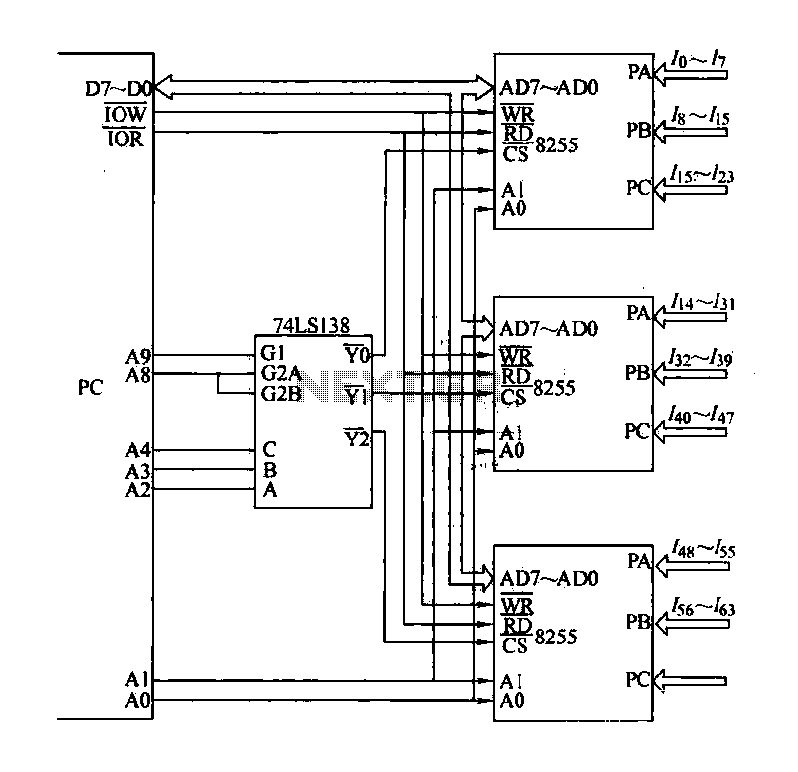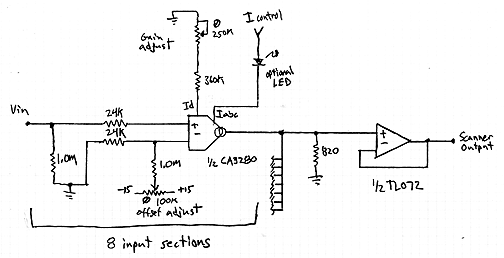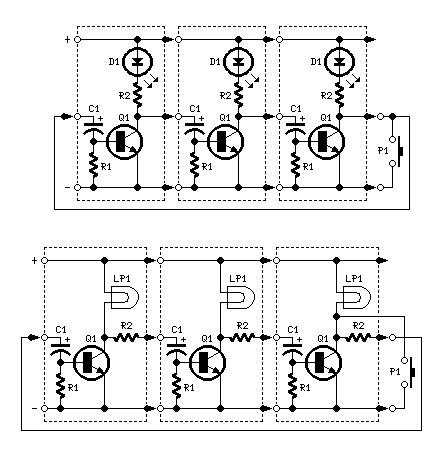
8255 uses 64 input expansion interface circuit

The computer control system is designed to detect signal path switching, requiring multiple input interface expansions. This system can switch all signal inputs into the computer. By utilizing a programmable chip, the 8255 expansion input interface allows for three I/O ports per chip. After complete initialization via programming, it can accommodate up to 24 digital signals. Consequently, the number of required 8255 chips can be calculated based on the volume of switching signal inputs. Figure 27-29 illustrates the circuit using the 8255 expansion interface for 64 inputs.
The described computer control system employs the 8255 programmable peripheral interface (PPI) to facilitate the management of multiple digital signal inputs. The 8255 chip is a versatile device that provides three 8-bit parallel I/O ports, thereby enabling the connection of up to 24 digital signals per chip. This capability is essential for applications requiring extensive input handling, such as automated control systems or data acquisition setups.
To implement the system, the 8255 chips need to be properly initialized through a microcontroller or microprocessor, which configures the chip's operational mode and sets the necessary control registers. This initialization process is crucial as it determines how the I/O ports will function—whether as input or output, and the mode of operation (e.g., mode 0 for simple I/O, mode 1 for strobed I/O, or mode 2 for bidirectional data transfer).
For a system that requires handling 64 input signals, as depicted in Figure 27-29, a total of three 8255 chips would be necessary, as each chip can handle 24 signals, allowing for a total of 72 signals. The design should incorporate adequate power supply considerations, as well as signal conditioning components, to ensure reliable operation of the inputs. Additionally, the circuit should include pull-up resistors on the input lines to prevent floating states and ensure stable readings.
The schematic should clearly depict the connections between the microcontroller, the 8255 chips, and the input signal sources. It is also advisable to include decoupling capacitors near the power pins of the 8255 chips to minimize noise and ensure stable operation. Overall, the circuit design must account for the physical layout, ensuring proper grounding and minimizing interference from adjacent components.Computer control system, you can detect the signal path switching means dressing a lot, you need a lot of input interface expansion Wei, so can all switch signal input into the computer. When using a programmable chip 8255 expansion input interface, there are 8255 per piece 3 1/0, pass through the program in its entirety is initialized to enter work, you can enter up to 24 digital signals, therefore, according to the switching signal input large ones it can calculate the required number of 8255 chips. Figure 27-29 shows using 8255 expansion interface circuit 64 inputs.
The described computer control system employs the 8255 programmable peripheral interface (PPI) to facilitate the management of multiple digital signal inputs. The 8255 chip is a versatile device that provides three 8-bit parallel I/O ports, thereby enabling the connection of up to 24 digital signals per chip. This capability is essential for applications requiring extensive input handling, such as automated control systems or data acquisition setups.
To implement the system, the 8255 chips need to be properly initialized through a microcontroller or microprocessor, which configures the chip's operational mode and sets the necessary control registers. This initialization process is crucial as it determines how the I/O ports will function—whether as input or output, and the mode of operation (e.g., mode 0 for simple I/O, mode 1 for strobed I/O, or mode 2 for bidirectional data transfer).
For a system that requires handling 64 input signals, as depicted in Figure 27-29, a total of three 8255 chips would be necessary, as each chip can handle 24 signals, allowing for a total of 72 signals. The design should incorporate adequate power supply considerations, as well as signal conditioning components, to ensure reliable operation of the inputs. Additionally, the circuit should include pull-up resistors on the input lines to prevent floating states and ensure stable readings.
The schematic should clearly depict the connections between the microcontroller, the 8255 chips, and the input signal sources. It is also advisable to include decoupling capacitors near the power pins of the 8255 chips to minimize noise and ensure stable operation. Overall, the circuit design must account for the physical layout, ensuring proper grounding and minimizing interference from adjacent components.Computer control system, you can detect the signal path switching means dressing a lot, you need a lot of input interface expansion Wei, so can all switch signal input into the computer. When using a programmable chip 8255 expansion input interface, there are 8255 per piece 3 1/0, pass through the program in its entirety is initialized to enter work, you can enter up to 24 digital signals, therefore, according to the switching signal input large ones it can calculate the required number of 8255 chips. Figure 27-29 shows using 8255 expansion interface circuit 64 inputs.





